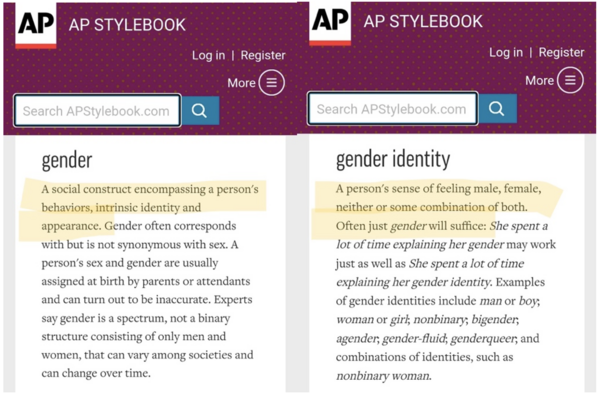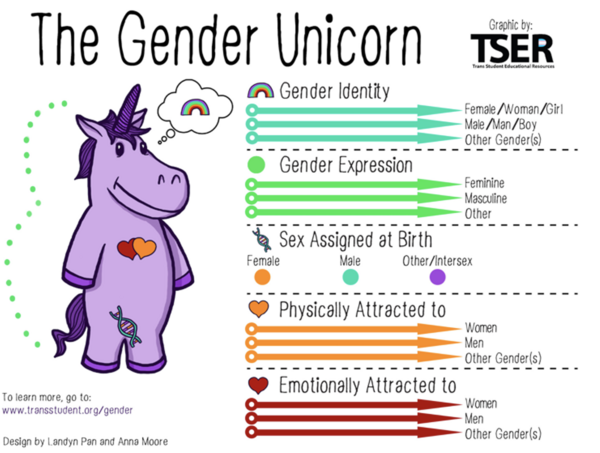Everyone is talking about gender. But what, exactly, is being said? Is gender a synonym for sex? Is gender the culturally constructed norms and expressions of sex? Is gender an innate sense of one’s sex, almost like a sex of the psyche or the soul? In truth, “gender” has become something of an empty signifier, a word with no stable definition that is nonetheless endlessly deployed, shifting meanings to suit a particular context or agenda. As such, one could argue that “gender” has become meaningless.
And yet one could pivot and argue the opposite: that “gender” is meaning-full, perhaps too much so, brimming over with too much meaning, too many definitions, less like an empty shell than a shape-shifting chimera.
In spite of—or perhaps because of—this meaningless meaningfulness, “gender” is rapidly reshaping our society: from the words we speak to the laws we craft to the spaces we inhabit to the medications we prescribe; no sphere of culture is untouched by gender’s influence. Thus, like every other institution, the Church must decide how to engage with this many-faced yet faceless demiurge, and perhaps the first question to resolve is this: should we abandon the word “gender?” Has it become too fraught, too unstable? Or should we attempt to redeem “gender,” to re-stabilize it in the firm ground of our sexuate nature? Is such a redemption possible?
What follows here is an attempt to answer this question: first, by articulating the depth of the quandary; second, by weighing the various options; and lastly, by proposing a way forward.
Gender’s Many Masks
When I began my feminist studies some twenty years ago, I was initiated into the classic framing of “sex” as a referent to biology, and “gender” as a referent to the various norms, interpretations, and expectations projected by culture onto sex. The seed of this bifurcation can be found in Simone de Beauvoir’s 1949 tome The Second Sex. As the title itself shows, de Beauvoir did not use the term “gender,” but she nonetheless articulated the concept that gender would soon come to name: “One is not born, but rather becomes, a woman.” Woman, in other words, is not a natural category, but a compilation of male fantasies, neuroses, and projections, inscribed and institutionalized by culture—religion, politics, literature, myth.
A decade or so later, sexologist and psychologist John Money introduced the terms “gender role” and “gender identity” into the academic landscape and began to promote the idea that gender was a product of socialization rather than inborn. While Money’s conception of “gender” was more akin to what is now termed “gender identity”—one’s sense of self as male or female—his formulation of gender as a social construct was readily embraced by second-wave feminists, who adopted the term “gender” to name Simone de Beauvoir’s notion of “woman” as a social fabrication. This is the classic sex/gender split, a prying apart of “woman” from “female,” wherein female is a factual matter of biology, and “woman” is a fever dream of the patriarchy, a delimiting machination of cultural origin. In this framing, not only is gender a social construct, it is an oppressive one—a construct that should be dismantled, endlessly deconstructed.
Far from an inner gnosis accessed by the self that, when actualized, is a source of the self’s authentic liberation—here, “gender” is imposed from without, by social power, and is thus inauthentic and enslaving. In fact, these seem to be two contradictory definitions:


Despite the diametric opposition of these concepts, in contemporary discourse, the term “gender” is used continually to depict both, leading to an almost constant yet unrecognized equivocation.
One example of this equivocation can be found in the recently released Associated Press guidelines for writing about gender—guidelines that are meant to establish clear norms for journalists to follow. These guidelines equivocate about the very definition of gender, and thus establish that equivocation as a norm.
The AP guidelines offer the following definition, describing gender as “a social construct encompassing a person’s behaviors, intrinsic identity, and appearance.”

This sentence is a valiant but incoherent attempt to harmonize two conflicting cliches: gender qua social construct and gender qua innate sense of self. The guidelines also offer yet another definition for “gender identity” as a “sense of feeling male, female, neither,” while simultaneously stating that often, just “gender” will suffice.
The equivocation is clear—both within the Hydra-headed definition of “gender” itself and between the given definitions of “gender” and “gender identity.” This equivocation is everywhere—not just on social media or in muddled everyday conversations, but in high-profile publications like textbooks and academic journals.
Kissing Gender Goodbye
One obvious path out of this linguistic bedlam is to ditch the term “gender” altogether and use “sex” instead. Many radical feminists have opted for this option—as well as some prominent anti-feminists, such as Catholic author Dale O’Leary, who argues that we should not say “gender” when we mean “sex.” There is an odd synergy on this question between the radical feminists and the conservative anti-feminists: both, for different reasons, are “gender abolitionists.”
This is the approach taken by Person & Identity, a project sponsored by the Catholic Woman’s Forum that seeks to be a resource for Catholics in responding to so-called “gender ideology.” Originally titled “The Gender Project,” the founders of Person & Identity rebranded, concluding that “gender” is a liability and not worth rehabilitating. The PIP thus seeks to respond to the problem of gender without using the word gender—a tricky feat to be sure.
“Gender,” asserts the project website, has an “ideological meaning that is incompatible with the Catholic understanding of the person.” They are not wrong on this. Remember the equivocating definitions mentioned previously? While these definitions contradict, there is one thread that connects them, as articulated recently by Angela Franks: what unites these two definitions “is the assumption of the non-naturalness of the sexed body”—an assumption that is at odds with Catholic anthropology.
The natural, sexuate body has been eclipsed. Gender has become something of an oversized, postmodern Pac-Man monster, gobbling up any term or referent to bodily sex and assimilating it. Gender’s voracious, ballooning dominance comes at the cost of sex’s receding influence. What began as a too-tidy but useful distinction between biology and culture has widened into an outright chasm, and sex has tumbled into the abyss. We now face, in contemporary discourse, a bewildering reversal of the second-wave split: now sex is the construct, the fiction, whereas gender (whatever that means) is deeply real.
The anti-genderists offer a grim warning: gender is like a Trojan horse; welcome it into your walls, and under cover of darkness, it will unleash Foucauldian foot soldiers into your imaginations and institutions. At best, “gender” breeds confusion and disarray; at worst, it colonizes our thoughts with anti-realist philosophy.
The Problem with Sex
Viewed from this apocalyptic angle, the choice seems an easy one: forget gender, use sex. This approach, however, comes with its own problems. If sex is the best alternative term, why did the Person & Identity Project not use “sex” in its title? I think we all know the answer. Sex, it turns out, is also burdened by equivocation. It’s most prominent, eye-catching meaning is genital activity of various kinds. If I were to write a book entitled A Theology of Sex, one can guess what the majority of perusers would assume the book to be about—only to then be disappointed.
The term “biological sex” has emerged, in great part, as a helpful signal that no, we do not mean that kind of sex. But this is cumbersome and arguably smuggles in unwanted philosophical premises of its own, such as the implication that there might be other kinds of sex, like “brain sex” or “psychological sex,” as if “biological sex” refers to only those bits between the legs, rather than a structural determinant of the entire body. Or that there is an aspect of personhood that is “merely” biological, but that one’s psyche or spirit could be untouched by the reality of sex.
A key thinker with a distaste for sex—no, not that kind—is Ivan Illich. While many Catholic intellectuals, such as myself, have found ourselves tracing and bemoaning the “eclipse of sex by the rise of gender” in the twentieth century, Illich rolls the tapestry of history back a bit further to the industrial era, bemoaning the “transmogrification of gender to sex.” Illich’s understanding of gender is neither the second-wave iteration or Butler’s later innovation; he is speaking of gender as a world, separate domains of “places, times, tools, tasks, forms of speech, gestures, and perceptions that are associated with men” and “associated with women.” Gender, in this sense, is always embedded in a local, material culture, and the industrial economy transformed gendered beings “into something new, into economic neuters distinguished by nothing more than their disembedded sex.” In this new system of sex, “a characteristic but quite secondary bulge in the blue jeans is now all that differentiates and bestows privilege on one kind of human being over another.” Sex is ironically neuter, “a kind of plumbing system channeling a genderless force that […] Freud called ‘libido’” (Illich, Gender). While “sex can be discussed in the unambiguous language of science,” Illich writes, “gender bespeaks a complementarity that is enigmatic and asymmetrical. Only metaphor can reach for it.”
Illich’s analysis is a helpful reminder that sex, too, has a conceptual genealogy and has taken on a reductive meaning in the wake of the Industrial Revolution. Like “gender,” the term “sex” smuggles unwanted philosophical and anthropological baggage on board.
To put this quandary simply: in our time, “gender” has become too disembodied, yet “sex” is too disembedded. What’s a girl to do?
The “And” Won’t Save Us
It has become increasingly common, perhaps in response to all this linguistic confusion, to hear the term “sex and gender.” This is often a good faith attempt to be thorough and inoffensive, to take hold of the chaotic bouquet of meaning those terms have come to evoke and offer them hastily to one’s listener, who is likely just as confused.
I have argued in my own work, and restated here, that the initial distinction between sex and gender ultimately led to a fragmented view of human personhood and paved the way for the engulfment of “sex” by the amorphous “gender” that we see playing out today. The most pronounced illustration of this is the now-ubiquitous Gender Unicorn infograph, which presents the human person as a pick-n-mix assortment of rearrangeable parts that have no intrinsic interconnection.

In this vision, “gender identity,” “gender expression,” “sex assigned at birth,” “physical attraction,” and “emotional attraction” are all presented as not only distinct but separable. The drift from distinction to separation is always a philosophical hazard, and the sex/gender split has followed this line of entropy into the shambolic rainbow mishmash of the Gender Unicorn.
The phrase “sex and gender” reinforces this separation, and as theologian Margaret McCarthy has effectively argued, this framing “cannot but further deepen the dualisms it was invented to create—between nature and nurture and biology and identity.” McCarthy’s proffered solution is to “insist on the use of a single term” that can accommodate carefully made distinctions “while not sacrificing the unity between them.” She suggests the term “sexual difference” as an option, which pleases my Irigarayan sensibilities and certainly seems viable in an academic context, and when speaking of the sexes generally and corporately. But it seems limited as a holistic anthropological term, one capable of denoting personal identity. Speaking of Irigaray, in her later works she coins the term “sexuate” as an alternative to “sexual,” to avoid the connotations of erotic attraction and activity. Let us look at these three options:
I want to more deeply understand my sexual difference as a woman.
I want to more deeply understand my sexual nature as a woman.
I want to more deeply understand my sexuate nature as a woman.
Of these three, I prefer “sexuate nature.” Sexual nature is, well, too “sexy”—evoking desire rather than personhood. And sexual difference in this instance arguably lends itself to an overly oppositional frame for contemplating womanhood, eliding the shared humanity of the sexes and the ways in which they are alike. Sexuate nature seems capacious enough to evoke both femaleness and humanness, which in my person are one.
However, every time I have tried to use the term “sexuate” in non-academic writing, my editors have said, “You can’t use that term. No one knows what it means.”
And here we find ourselves, once again, in an aporia.
The problem is that I mostly agree with everyone thus far: gender has taken on too many meanings, the most prominent of which are incompatible with a Catholic anthropology. Yet sex is too clinical, too medical, tending toward a biological reductionism that abstracts the human person away from the spiritual, psychological, cultural, and historical realms. And the catch-all “sex and gender” reinscribes the dualistic fragmentation of personhood, rather than healing it. “Sexual difference” is a viable term in certain contexts, but not all, and I just can’t seem to get “sexuate” official coinage.
And the practical challenges matter, at least for me, because I want to speak and write in a way that can be heard. I do not want to speak only to an insular academic audience that is overly enthusiastic about the invention of novel, esoteric terms; I want to speak to the ordinary person in the pew.
This ordinary person, I will confidently bet, is far more apt to use the term “gender” than any other term—and what they likely mean when they use that term is a person of a certain sex: i.e., men are the male gender, and women are the female gender.
This is the pedestrian language of the uninitiated, the uninformed, the supposed ignorami whose sensibilities have not been sufficiently shaped by critical theory or slogans punctuated by hand-clap emojis. This is the language of the naïve and benighted who blithely conflate gender with sex, who instinctively assume that men are male and women are female.
And this is precisely why we should embrace it.
Regenerating Gender
Despite the cultural dominance of disembodied “gender” in elite environments and on social media, it has not wholly colonized the mind or tongue of the average person. This presents us with an opportunity for redeeming the term “gender,” to build upon that intuition that gender is rooted in the sexed body, and that one’s gender refers simultaneously to one’s sex and one’s personal identity as man or woman—because those are inseparable.
This is the approach suggested by philosopher Prudence Allen—“ransoming” gender as a method of evangelization. She writes:
In ordinary use of the word “gender,” the human being is identified as male or female, man or woman. I would argue that the more the word “gender” is used by men and women within a Catholic understanding of the way in which a man and a woman are equally human persons and simultaneously two significantly different ways of being a human person, this will help ransom gender from its present ideological distortions.
Allen argues that “the first step in ransoming gender reality is to reclaim the meaning of the root ‘gen,’” an etymological root that evokes generation. Gender, then, is ultimately grounded in generativity.
Gender, in the holistic and Catholic sense I am advocating, is a term that names one’s sexuate human nature as a man or a woman. Gender is not part of a person, contra the Gender Unicorn, but rather encompasses the whole person. Thus, gender includes one’s sexed biological structure, as well as the psychological, spiritual, and historically-situated dimensions of human personhood.
What is arguably lost in the dichotomy of sex and gender is the wholeness, the completeness of the human person. But deploying gender as a personal category, i.e., referring to the sexuate person as a whole, makes it potentially a tool for integration rather than fragmentation.
Gender, in this usage, includes sex, but carries a fuller meaning, because it is indicative of a person rather than a reproductive niche. Plenty of living things have sex, but most of those living things are not human persons; we can speak of them as male and female, but not man or woman. To illustrate this point by way of an SAT analogy: “gender” is to woman as “sex” is to female.
This raises an interesting question, which I will leave hanging in the air for further contemplation: does this mean that gender, as I have defined it, is unique to human persons, i.e., the only beings who have the twin potential for both sexual reproduction and divine communion? Both are, after all, integral aspects of being a woman, and any contemplation of my womanhood must be grounded therein.
While I am making a finely tuned distinction between gender (e.g., woman) and sex (e.g., female), because gender cannot be separated from sex, in ordinary speech we can use these terms as synonyms. Yes: I am suggesting that we intentionally and enthusiastically violate the taboo against conflating sex with gender, as a strategy of reintegration.
Beyond the informal, everyday usage, in more formal contexts (essays, talks, homilies) gender can be used but should be clearly defined as grounded in generative potential and referring to a whole human person. I do not think this is as much of a leap as it perhaps feels for those who have been schooled in academic gender theory. This is because using the term “gender” in this way confirms our intuitive knowledge, whereas gender theory contradicts it. The innate ability, carefully honed over millions of years of evolutionary development, to immediately recognize whether someone is a man or a woman from fifty paces: this knowledge must be actively unlearned before one can accept that a woman is anyone who says so.
In other words, the leap goes the other way. It is a leap for someone to convince herself that gender refers to something entirely constructed and external to the self, and it is an even greater leap to see gender as an ethereal and wholly internal reality that remains completely imperceptible and unknowable until disclosed.
In order for the regeneration of gender to be successful, we also have to abstain from using “gender” in a disembodied sense, either as a social construct or as a subjective sense of self. Instead, we can use other plain-sense phrases to capture those displaced meanings, such as “gender norms” or “cultural articulations of gender” or “self-concept,” “self-perception,” etc.
Finally, a post-script: there is one sphere, however, which for the moment should remain gender-less, where the term sex should be exclusively used. That is in the law. “Gender,” in its current intangible form, is too divorced from the concrete reality of the sexed body. It will take time to regenerate gender. And if in the interim gender qua construct and/or self-declaration becomes encoded in the law, we will have a much bigger knot to untie.


